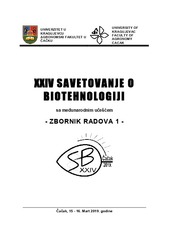Приказ основних података о документу
Ekonomski najznačnije bolesti i korovi u proizvodnji uljane repice i mogućnosti njihovog suzbijanja
| dc.creator | Mitrović, Petar | |
| dc.creator | Marjanović-Jeromela, Ana | |
| dc.creator | Milovac, Željko | |
| dc.creator | Perviz, Mehira | |
| dc.date.accessioned | 2021-10-14T17:19:01Z | |
| dc.date.available | 2021-10-14T17:19:01Z | |
| dc.date.issued | 2019 | |
| dc.identifier.isbn | 978-86-87611-63-4 | |
| dc.identifier.isbn | 978-86-87611-69-6 | |
| dc.identifier.uri | http://fiver.ifvcns.rs/handle/123456789/2306 | |
| dc.description.abstract | Uljana repica (Brassica napus var. napus L.) se gaji radi semena koje sadrži 40-48% ulja i 18-25% belančevina. Ulje je visokog kvaliteta te se može koristiti i za ishranu ljudi. Proizvodnja biodizela iz repičinog ulja predstavlja osnovni razlog gajenja ove kulture u našoj zemlji. Kao i kod drugih biljnih vrsta smanjenje prinosa, pored klimatskih faktora i agrotehničkih mera, može biti izazvano i neblagovremenom zaštitom od prouzrokovača biljnih bolesti i korova. Od korovskih vrsta najveći problem predstavlja Sinapis arvensis (gorušica). Problem se ogleda u tome što je navedenu korovsku vrstu teško suzbiti (agrotehničke i hemijske mere), jer pripada istoj familiji kao i uljana repica. Od fitopatogenih gljiva ekonomski najznačajnije su Sclerotinia sclerotiorum, Phoma lingam i Peronospora parasitica. Navedeni paraziti u povoljnim klimatskim uslovima mogu izazvati oboljenja na biljkama uljane repice. | sr |
| dc.description.abstract | Oilseed rape (Brassica napus var. Napus L.) is grown for seeds containing 40-48% oil and 18-25% protein. The oil is of high quality and can also be used for human consumption. The production of biodiesel from rapeseed oil is the main reason for cultivating this culture in our country. As with other plant species, yield reductions, in addition to climate factors and agro-technical measures, can also be caused by untimely protection against plant diseases and weeds.Of the weed species, the largest problem is (Sinapis arvensis )wild mustard. The problem is that the weed species mentioned above can be difficult to control (agro-chemical and chemical measures) because it belongs to the same family as rapeseed. Of the phytopathogenic fungi economically most important Sclerotinia sclerotiorum, Phoma lingam i Peronospora parasitica. The listed parasites in favorable climatic conditions can cause diseases on the plants of the rapeseed. | sr |
| dc.language.iso | sr | sr |
| dc.publisher | Čačak : Univerzitet u Kragujevcu, Agronomski fakultet | sr |
| dc.relation | info:eu-repo/grantAgreement/MESTD/Technological Development (TD or TR)/31025/RS// | sr |
| dc.rights | openAccess | sr |
| dc.rights.uri | https://creativecommons.org/licenses/by/4.0/ | |
| dc.source | Zbornik radova 1, 24. Savetovanje o biotehnologiji sa međunarodnim učešćem, 15-16. mart 2019., Čačak | sr |
| dc.subject | uljana repica | sr |
| dc.subject | bolesti | sr |
| dc.subject | korovi | sr |
| dc.subject | mere zaštite | sr |
| dc.subject | rapeseed | sr |
| dc.subject | diseases | sr |
| dc.subject | weeds | sr |
| dc.subject | protection measures | sr |
| dc.title | Ekonomski najznačnije bolesti i korovi u proizvodnji uljane repice i mogućnosti njihovog suzbijanja | sr |
| dc.type | conferenceObject | sr |
| dc.rights.license | BY | sr |
| dc.citation.epage | 403 | |
| dc.citation.spage | 395 | |
| dc.identifier.fulltext | http://fiver.ifvcns.rs/bitstream/id/6075/bitstream_6075.pdf | |
| dc.identifier.rcub | https://hdl.handle.net/21.15107/rcub_fiver_2306 | |
| dc.type.version | publishedVersion | sr |


